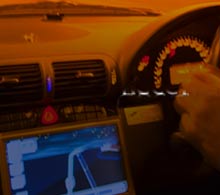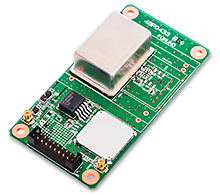Articles for ITS market Big data’s initiative and fight for the automotive industry. Cooperation among companies becomes increasingly important.
Switch from manufacturing to data business
The automobile industry is now in the midst of a major transition period that is cyclical and happens after many years of low technological growth. In the beginning of December I witnessed these changes at the US semiconductor giant NVIDIA sponsored, 2017 GTC (GPU Technology Conference) Japan show in Tokyo on December 12th and 13th.
GPU (Graphics Processing Unit). It is a semiconductor (processor) used for arithmetic processing of images as the name suggests. In recent years, it is often used for deep learning and image recognition (Image Recognition) in automatic driving systems. Generally this field is called artificial intelligence (AI).
Until now the positioning of semiconductor manufacturers in the automotive industry was considered tier 2 (secondary subcontractor), who is a supplier to automotive parts manufacturers. Technically the main purpose was to accuracy operate various operation devices such as engines, transmissions, power steering, etc.
However, in recent years, demand for high-performance semiconductors has increased for new technical fields including collaboration between automated vehicles, embedded system (smartphone) and the cloud and image recognition for autonomous driving.
At the recent GTC show the keynote speech by Mr. Jensen Huang, CEO and founder of NVIDIA strongly promoted autonomous driving for the automobile industry.
Also at the end of November I visited the new building at NVIDIA in San Jose, California and received detailed information regarding the company's automatic vehicle operation. In addition individuals from Intel headquarters (a NVIDIA competitor) also visited and attended an automated driving workshop.
The biggest reason why Silicon Valley semiconductor giant has decided to make full-scale entry into the automobile industry is to commercialization and utilize the new big data segment.
Toyota and Panasonic strength their collaboration
Mr. Jensen Huang, CEO of NVIDIA had about a 2 hour speech at the 2017 GTC Japan show. Toward the end of the speech I received a message on my mobile phone. The message was sent by TOYOTA’s Public Relations Department. It said there would be a joint press conference between Toyota and Panasonic at 3 p.m. later that day in Tokyo. The conference made a general announcement and notified us of the big news. I adjusted my afternoon schedule and took a seat in the middle, front row in the Toyota Panasonic press conference. During the question and answer session I had an opportunity to ask questions to Mr. AKIO TOYOTA, a president of Toyoda and Mr. KAZUHIRO TSUGA, a president of PANASONIC.
The main point of the press conference is to confirm the two companies are collaborating to develop prismatic lithium ion secondary batteries for EV’s (Electric Vehicles). However, the detailed contents were not disclosed including who, when, how long, and how the cooperation is structured. Batteries for hybrid vehicles continue to be delivered from PANASONIC to TOYOTA. However the overall significance of this meeting was to confirm both companies will extend their partnership beyond batteries to include future comprehensive technical alliances. There are many press outlets who think that they will include “big data” as a key point in this alliance.
Big data becomes larger, but the business model is still unknown.
How do you utilize and commercialize big data in the automobile industry? The business model has not been established yet. For example in TOYOTA’s case there is a mobility service platform that has been announced for end of 2016.
By 2020 TOYOTA will equip vehicles with DCM (data communication module) for transmitting and receiving data to the cloud for all new cars released in Japan. TOYOTA can obtain detailed user data on how the the car is being used such as GPS position information, acceleration / deceleration angle (Steering Angle), etc.
It is conceivable such big data would first be detected and later the user would be notified of the failure and guided to the dealer. This would help increase profit to the dealer. Regarding car insurance, the basic system of insurance will change from “PAYD” (Pay As You Drive) corresponding to "travel distance" to “PHYD” (Pay How You Drive) corresponding to "how did you drive".
Various vehicle usage method models can be combined including new car sales, used car sales, leasing, and car sharing among individuals. In response to the user's driving habits and lifestyle it is possible to improve user convenience and reduced costs can be achieved.
By understanding “big data” in this way the automobile industry will make a major shift from traditional manufacturing and sales business model to a more service oriented industry by utilizing big data.
As a result relationships between automobile manufacturers and other companies will continue to strengthen. This includes semiconductor manufacturers NVIDIA, INTEL and electric manufacturers like PANASONIC, SONY, and cloud providers like AMAZON, GOOGLE and MICROSOFT etc.
Writer introduction

Mr. Kenji Momota Automotive journalist
His major is the world automotive industry and he is also familiar with the energy industry, IT and the aging society problem as the related fields. He acts around the world based in Japan and USA and writes for the general magazines, the technology journals and the automotive related media etc.
He is also commentator of motor race and world's motor show on TV program based on his career of the driver of Indy Racing League and NASCAR. In recent years, he has been covering about a paradigm shift from developed countries to developing countries, the motorized vehicle like EV and the telematics.
FURUNO ITS Journal
Click here for the latest articles after 2022 (in Japanese)2022
- The "realistic" self-driving roadmap shown by the Japanese government and a hands-on report on the latest Subaru EyeSight X
- Will FCVs (Fuel Cell Vehicles) Become Popular? ~New Movement in Toyota and Honda~
- The 'Complete' online sales of new cars start in Japan. Will this new way of buying cars take root?
- Many Firsts! On-Site Report from Tokyo Auto Salon 2022 - The author, who knows what goes on behind the scenes, looks back on 40 years of history. -
2021
- "Moving toward zero traffic fatalities for four-wheeled and two-wheeled vehicles globally in 2050" ~Experience on Honda's latest safety technologies~
- Tsuneishi Shipbuilding's building and DX, an exclusive visit to the main factory
- Japan's Smart City: New Moves toward Practical Use
- When will self-driving buses (service cars) be put to "full-scale" practical use?
- Utilization vehicle data during disasters
- Toyota-led Connected Technology to Transform Commercial Vehicle Business -From light trucks to large trucks and buses-
- Toyota enters the connected car "Personalization" business
- Japanese automakers' carbon-neutral strategies swept up in ESG investment
- Drive experience of the latest autonomous vehicle models and advanced driving support systems
- Will carbon neutrality accelerate the trend to strengthen LCA (Life Cycle Assessment)?
- Semiconductor shortage exposes realities of the automotive industry
- Online Autonomous Driving Contest Enhancing development of Human Resources
2020
- What happens to CASE when gas cars are banned in Japan?
- When will Flying Cars be launched?
- Expectation vs. reality:Autonomous Driving in Japan
- V2X, Becoming increasingly important in autonomous driving
- Technology of Subaru “EyeSight X”
- Lifestyle-oriented French cars gain popularity in Japan
- Human-oriented smart cities are wanted
- MaaS and CASE, how would automotive industry change after COVID-19?
- The beginning of virtualization era, triggered by COVID-19
- Trend of EV shift and consumer demands
- TOYOTA Press conference about ADAS - Releasing algorithm for "sudden acceleration suppression during attempted sudden acceleration" free of charge -
- The Japanese automotive industry in 2020 - 3 turning points -
- "Using a smartphone while driving" and "Level 3 automated driving"
2019
- Motor show business model is at a turning point - Tokyo Motor Show Report -
- Commercialization and monetization of MaaS - ITS World Congress Singapore Report -
- Android Automotive pays attention to V2X - Report from the Frankfurt Motor Show 2019 in Germany -
- Automobile Distribution Revolution and DCM (Data Communication Module)
- Connected business potential and newly proposed "eMaaS" by Honda
- 5G services for practical use are multiplying
- Connectivity technologies attracting attention due to frequent traffic accidents
- Shanghai Motor Show report -SUV, EV, Automated car & 5G-
- Drone Business roadmap and updates to Michibiki (Quasi-Zenith Satellite System)
- MaaS (Mobility as a Service) "town development." Full-scale promotion for a national project
- CES organizer states "Data Period in 2020s." Transformation of the Automotive Industry in CES, US "-CES2019 Report-"
- "Return to Origin" directed towards the age of change, automatic operation and connectivity
2018
- New proposal for Private Car Automated Driving Level and other Hot 5G Technology Topics
- Standardized EV charging infrastructure concerns in Europe, US, Japan and China - Kobe EVS 31 field report -
- Touring a pure car carrier and a test drive of the latest hybrid car
- Planning stage products are exhibited at the newly established visualized mobility service "TOYOTA MOBILITY SHOWROOM".
- Potential “Community Car-share” program promoted by local residents
- CES Asia Report 2108
- Companies attempt new Vehicle-to-Infrastructure communications, including traffic volume measurements and vehicle positioning. -ITS Asia Pacific Forum in Fukuoka-
- Geneva show in Switzerland. Flying cars and MaaS (Mobility as a Service) were hot topics.
- EV (Electric Vehicle) proposals by country
- MaaS competition through service mobilization, M & A and technical field collaboration is accelerating. - The CES 2018 Report -
2017
- Big data’s initiative and fight for the automotive industry. Cooperation among companies becomes increasingly important.
- Connected car and road-to-vehicle communication automatic operation
- ETC (Electronic Toll Collection) and ETC2.0. Current situation and projected future
- Rapid development of sharing economy
- Germany is first to recognize level 3 automated driving
- ITS EU 2017 Field Reports -Automatic Operation and the eCall-
- From Infotainment to ITS, the competitive area is spreading in the car big data industry.
- GTC (GPU Technology Conference) Report and the de facto standardization of AI (artificial intelligence)
- Renesas' new challenge! "e-AI Solution" and "Renesas Autonomy"
- The Automobile industry is shifting from a manufacturing industry to a service industry.
- The movement toward accident countermeasures for aging drivers in Japan
- Fusion of ride sharing and fully automated driving is advancing in the USA.
2016
- Overview of the Quasi-Zenith Satellite System (QZSS) and advancements toward full-scale practical use including the Tokyo Olympic Games - G-space EXPO 2016 report-
- Japan’s automated driving project "SIP-adus" will be a large demonstration experiment.
- The International Home Care & Rehabilitation Exhibition. There were many car manufactures with exhibits booths at this show.
- Japanese car manufacturers starting to concentrate on strengthening the ADAS system
- A new movement of legislation for autonomous cars
- Cyber Security and “AGL”, the new OS for automotive are hot topics in the connected car industry
- “High precision 3D map” the key future of autonomous car and pedestrian dead reckoning
- Chinese “BAT” is accelerating their business in the EV (Electric Vehicle) market
- Tesla's original connection to Taiwan and the new transportation system technologies.
- "The main topic" of the Geneva Motor Show was how to strengthen "pedestrian protection"
- The probe data business is getting more competitive
- Reporting directly from the 2016 CES show "Data services will soon become the main revenue source of automotive industry"
2015
- Do the automated driving systems need the GNSS (Global Navigation Satellite System) ?
- ETC Version 2.0 is coming soon. A new service was announced at the Tokyo Motor Show and the possibility that is could be used as a device for older drivers.
- "Connected Horizon" and "eHorizon". Germany's leading parts supplier accelerates strengthening of "Big Data" for business



 Mr. Jensen Huang, CEO of NVIDIA had a speech in the GTC Japan show 2017.
Mr. Jensen Huang, CEO of NVIDIA had a speech in the GTC Japan show 2017.  TOYOTA and PANASONIC announced cooperation for development of a prismatic battery for EV. The presidents of the two companies participated and held a presentation in Tokyo.
TOYOTA and PANASONIC announced cooperation for development of a prismatic battery for EV. The presidents of the two companies participated and held a presentation in Tokyo.  Overall view of Toyota's proposed mobility service platform. Source: Toyota Motor Corporation.
Overall view of Toyota's proposed mobility service platform. Source: Toyota Motor Corporation. GPS/GNSS Receiver&Chips and Modules (positioning and timing)
GPS/GNSS Receiver&Chips and Modules (positioning and timing)